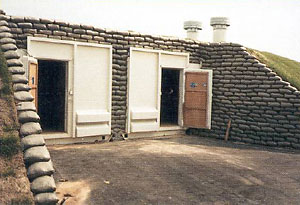What's in This Document
 |
Security Requirements
Type 1 (27 CFR § 555.207), Type 2 (27 CFR § 555.208), Type 4 (27 CFR § 555.210), Type 5 Magazines (27 CFR § 555.211)
Each door on type 1, type 2, type 4, and type 5 explosives storage magazines containing explosive materials subject to 27 CFR, Part 555 – Commerce in Explosives must generally be secured with one of the following methods:
- Two mortise locks.
- A mortise lock that requires two keys to open.
- Two padlocks fastened in separate hasps and staples.
- A combination of a mortise lock and a padlock.
- A three-point lock.
If padlocks are used, they must have at least 5 tumblers and at least a ⅜-inch thick case-hardened or boron alloy shackle. Padlocks must also be protected with at least ¼-inch thick steel hoods constructed to prevent the sawing or lever action on the padlocks, including the lock hasps and staples.
The locking requirements do not apply to doors that are adequately secured on the inside by means of a bolt, lock, or bar that cannot be actuated from the outside.
The doors on indoor magazines located in secure rooms must only be secured with one steel padlock that need not be protected by a ¼-inch thick steel hood. A room is only considered “secure” when it is locked exactly as a magazine (e.g. two mortise locks, three-point lock, etc.).
Each door on type 5 vehicular magazines (e.g., trailers, semitrailers) must only be secured with one steel padlock that need not be protected by a ¼-inch thick steel hood. Refer to 27 CFR § 555.211(a)(4).
Vehicular magazines must also have their wheels removed or be immobilized by a kingpin locking device.
Type 2 Detonator Boxes and Type 3 Magazines
- Each door must be secured with one steel padlock that has at least 5 tumblers and at least a ⅜-inch thick case-hardened or boron alloy shackle. Refer to 27 CFR § 555.208(c) and 27 CFR § 555.209.
Magazine Inspections
All persons storing explosive materials must inspect their magazines at least every seven days. An inventory of the explosive materials is not required, but the inspection must be sufficient to determine if there has been unauthorized entry or attempted entry into the magazine, or unauthorized removal of the explosive materials within the magazine. Magazine inspections are only required when explosive materials are stored in the magazine. Refer to 27 CFR § 555.204.
ATF Lock-Related Rulings
ATF Ruling 2004-3: Allows indoor type 4 magazines to be secured with flush mount bolt-style locks utilizing interlocking solid metal parts, each affixed securely to the magazine in such a way that they cannot be readily removed from the exterior of the magazine and each locking mechanism having at least five tumblers.
ATF Ruling 2011-2: Allows for alternate locking methods for outdoor type 5 bins and silos containing bulk blasting agent.
ATF Ruling 2011-3: Allows for magazines to be secured with hidden-shackle “hockey puck” locks, recessed padlocks, and padlocks with boron alloy shackles.


